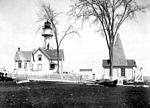State University of New York Maritime College
1874 establishments in New York (state)Educational institutions established in 1874Maritime colleges in the United StatesMilitary academies of the United StatesPublic universities and colleges in New York (state) ... and 4 more
State University of New York Maritime CollegeThroggs Neck, BronxUniversities and colleges in the BronxUse mdy dates from December 2018
State University of New York Maritime College (SUNY Maritime College) is a public maritime college in the Bronx, New York City. It is part of the State University of New York (SUNY) system. Founded in 1874, the SUNY Maritime College was the first college of its kind (federally approved, offering commercial nautical instruction) to be founded in the United States and is one of only seven degree-granting maritime academies in the United States.
Excerpt from the Wikipedia article State University of New York Maritime College (License: CC BY-SA 3.0, Authors).State University of New York Maritime College
Pennyfield Avenue, New York The Bronx
Geographical coordinates (GPS) Address External links Nearby Places Show on map
Geographical coordinates (GPS)
| Latitude | Longitude |
|---|---|
| N 40.805277777778 ° | E -73.7925 ° |
Address
SUNY Maritime College (State University of New York Maritime College)
Pennyfield Avenue 6
10465 New York, The Bronx
New York, United States
Open on Google Maps





